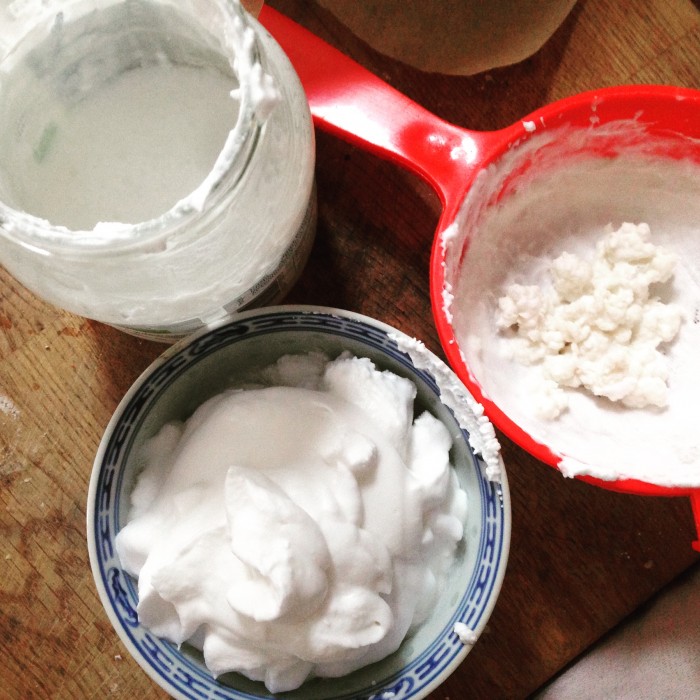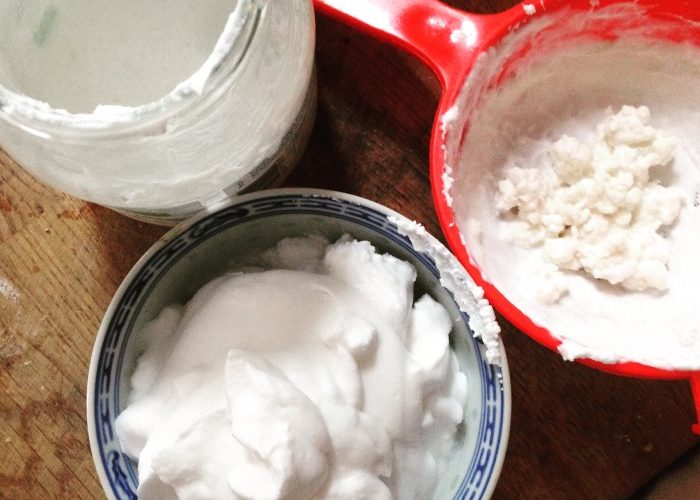
Milk kefir is a cultured dairy originally from the Caucuses – the region where Europe meets Asia. There it has been traditionally heralded as an elixir of long life and health. Milk kefir is rich in beneficial bacteria, phosphorus, vitamin K, biotin and folic acid – nutrients that are essential to health and well-being. A single component of milk kefir may prove particularly beneficial as it successfully protects beneficial bacteria from damage in the hostile environment of the digestive tract. Milk kefir is strongly anti-inflammatory. For more info on the history & health benefits of milk kefir, check out this article.
Milk kefir grains are white, lumpy and gelatinous and are comprised primarily of lactic acid producing bacteria. Though, of course, strains of bacteria present may differ from one culture of grains to another. Milk kefir grains are, like kombucha cultures, also a SCOBY (symbiotic colony of bacteria and yeast). However, unlike kombucha SCOBYs which grow in a disk shape, milk kefir grains grow in small cauliflower-shaped, jelly clusters.
Once you’ve acquired a kefir grains, simply mix them in with milk – preferably raw, but any kind of milk will do, the higher fat content the more thick and creamy it will become – and allow it to culture at room temperature for 24 – 48 hours. If you are able, give it a stir or a shake to make sure the grains come into contact with the milk as often as possible. As it cultures at room temperature, the beneficial strains of bacteria and benign natural yeasts will proliferate, metabolize the milk’s lactose and create a sour, thick beverage with vitamins, probiotics, kefiran and other nourishing components. You will notice that in warmer temperatures coagulation (thickness) develops more quickly. You can consume milk kefir as a slightly thicker, drinkable milk product (perfect for making smoothies) or let it culture longer until it separates into curds and whey. The longer milk kefir cultures the more sour and foliate-rich it becomes, but take care not to culture it too long lest it become unpalatable.

Ingredients:
1 tablespoon milk kefir grains
½ litre milk (roughly)
Instructions: Place milk kefir grains in the bottom of a clean mason jar. Cover with fresh milk. Place a lid loosely or place well secured, tight weave cloth, on top of the mason jar. You do not want to tighten a lid because, as with all fermentation, carbon dioxide is created and needs to escape. Culture for 24 – 48 hours at room temperature. For a thin, milk kefir you can culture for 12 hours. Once culturing is complete, strain milk kefir into a new mason jar, cap and refrigerate. Begin re-culturing a new batch of kefir, if desired or allow your kefir grains to rest in water in the refrigerator for a few days until you’re ready to make kefir again.
Other Milks: As milk kefir grains feed on the milk sugar (lactose) that is naturally occurring in animal milk, these grains will not survive long term in lactose free milks such as soy, almond, oat or coconut milk. However, they still are able to ferment the milk creating a light sour and thickened ‘non-dairy’ kefir. From my experience with many milks, I find coconut milk (I prefer varieties sold in a tetra-pack rather than a can) works the best. Coconut kefir results in thick, fluffy probiotic clouds like the picture above after sifting out the kefir grains. I would alternate the grains from a lactose containing milk to a lactose free milk, so that the grains get a feeding in between each fermentation process and stay active.
Storage: Extra grains may be stored in the refrigerator in a glass jar in milk or whey – can be kept like this for many months even over a year – however the longer they are in hibernation, the longer they will take to restore and rejuvenate in fresh milk at room temperature. For longer-term storage you can also dehydrate the grains (at temperatures below 118 degrees so you don’t destroy the enzymes). To revive dormant grains, simply put them in a small amount of milk, you may find that it takes a few batches to restore their former vigor and taste.


Dear Alexis,
My daughter Rebecca baught some of your kefir grains in june and braught them to Italy where we live.
I tried severall times to make kefir, with different types of milk,it never worked out well. Twice the taste was’t`very good and it stayed watery. Number 3 and 4 just didn’t get thick and tasted souer.
What can i do to get a good result.
Thanks for your advise.
Looking forward to hear from you.
Greetings Gisela Ilse
Dear Gisela,
are you trying first with lactose milk such as COW, GOAT or SHEEPs milk? often with lactose free milk the milk kefir grains wont reproduce and multiply. best to try with full lactose milks. the fatter milks the better. milk kefir is technically a ‘drinking yogurt’ so wont get as thick as yogurt or cheese. with lactose environments they should multiply and be happy! keep trying, otherwise send Rebecca back to me and ill set her up with some more!